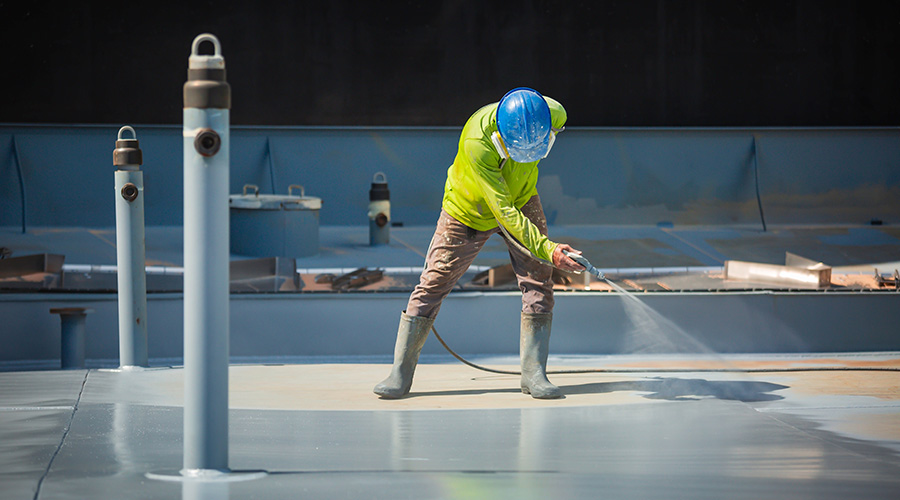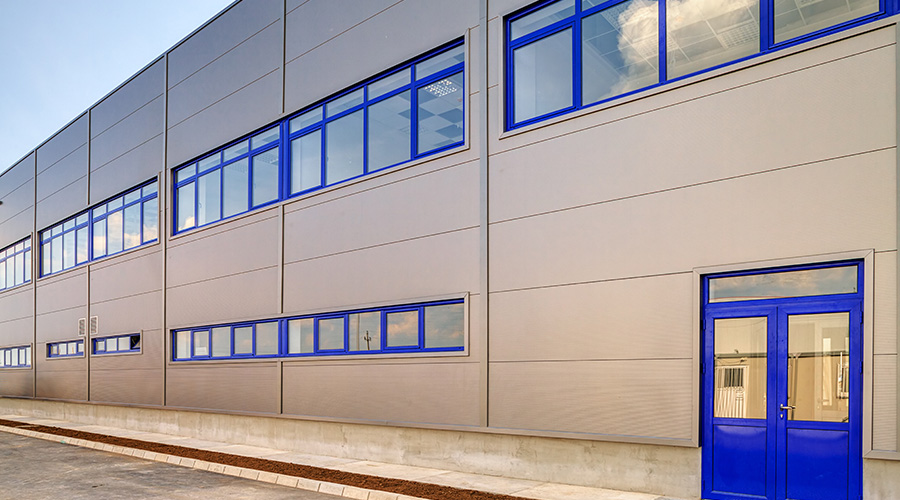A Closer Look at Paint-Spray Technology
An alternative to brushes and rollers gives managers an option that can control costs and produce long-lasting applications on facilities and equipment
Prompted by the need to control costs while still protecting facilities and equipment, many maintenance and engineering managers are looking for options when it comes to paint-application techniques. They are finding that many changes have taken place related to the task of paint application.
These changes include not only the demise of lead- and oil-based paints. They also include advances in the methods used to apply modern paints and coatings, including the rise of paint-spray technology. Understanding new products and procedures related to this technology will enable managers and paint crews to make specification and application choices that produce the longest-lasting paint jobs.
Benefits and Drawbacks
Among the benefits of conventional spray coating are greater operator control over the process and a wide range of coating materials. Also, using spray guns makes painting faster and easier. The primary reason that painters use spray systems these days is to control costs of both labor and material.
Spray-only applications are most appropriate for smooth surfaces on which rollers or brushes will leave undesirable finishes. These surfaces could include smooth lap siding, garage doors, metal equipment, and exterior metal doors, frames and gutters.
Spray painting has its limitations, however. While it might be too expensive to hand roll or brush an entire interior or exterior area, spraying a surface does not properly fill cracks or seal most rough-sawn wood or stucco surfaces. For these reasons, painters should roll and brush after most spray applications to enhance the look and achieve a longer-lasting paint job. A spray-only paint job simply will not hold up as long or as well as a brushed or rolled application.
To address coverage issues, managers also might consider newer acrylic coatings, which are formulated to penetrate and preserve both wood and stucco better than the best oil-based paints of old. The elastic nature of the product fills non-structural hairline cracks in wood, stucco and even masonry, virtually stretching when these surfaces expand and contract in response to environmental conditions.
Another disadvantage to conventional paint-spraying systems is that a high degree of atomization is accompanied by a very fine spray, which can cause overspray. The result is more paint wasted and low transfer efficiency.
Overspray is the main health hazard of the spray coating process. If overspray is not contained, it can drift and land on nearby materials or workers. Coatings also can bounce off or entirely miss the surface after leaving the spray gun.
Bounce-back usually results from paint partially drying before it reaches a part’s surface. Practices to prevent this problem include using a spray booth to contain the overspray. Since excessive pressure and poor operator techniques result in greater waste, better operator training can reduce the occurrence of overspray.
Technology and Options
The technology behind today’s spray application systems is relatively simple. For the most part, spray equipment is nearly as good as its likely to get, but manufacturers of spray guns, tips and related accessories keep refining their products to produce the right system that no facility painter can dare live without.
A basic spray-painting system consists of a conventional spray gun, a pressurized paint container, a compressed-air system, and flexible tubes connecting these components. Applying the coating material in a conventional system is fairly straightforward.
Conventional, or atomized spray, systems use air at high pressure — 40-70 pounds per square inch (psi) — to atomize a liquefied stream of paint. The high-energy air stream finely atomizes paint, making it easy to apply and yielding very good
finishes. This type of painting system has a transfer efficiency of 20-50 percent. Improper setup and painting techniques, however, will increase the amount of paint required and cost.
Paints and coatings also can be applied using other spray technologies, including:
- airless, or hydraulic
- air-assisted airless
- hot airless
- high-volume low pressure (HVLP)
- high-volume, stepped-down low pressure
- low-pressure, low volume
- thin film atomization.
Operators can use these technologies to apply a variety of materials with a range of viscosities.
HVLP spray gun with air control. This lightweight and compact palm-size gun can produce a professional quality finish. It is excellent for high-production trim work and can be used with compressors as small as 11&Mac218;2 hp.
HVLP mini-spray gun. This lightweight and compact type of spray gun is designed primarily for touch-up jobs. It replaces aerosol cans and can be used with smaller compressors. Using a high volume of low-pressure air to atomize finish-grade coatings, these units are designed to produce superior spray pattern control and dramatically reduce overspray and bounce-back. HVLP spray units can be effective tools when applying sealers, lacquers, stains, oil-based paints, and finish-quality latexes.
HVLP nozzle spray gun. This heavy-duty nozzle extension gun delivers quality finishes in hard-to-reach places, such as between pipes, in deep recesses and behind sills and frames, and it has interchangeable spray heads to accommodate a variety of applications.
Air-assisted spraying systems. This technology combines the best characteristics of both air and airless spray. Benefits include the ability to lower the fluid pressure from airless systems. Also, operator technique is enhanced because the application rate is slowed, making product coating easier. These systems also tend to generate material savings and minimize overspray.
Electrically operated airless pump. These systems can perform both smaller indoor jobs and larger renovation jobs. Their compact design and weight provide great mobility and flexibility.
Electrostatic systems. This method gives the paint and the surface opposite electrical charges. The surface’s electrical charge draws the paint to it, resulting in a higher paint-transfer efficiency. Paint spray is less susceptible in drafts and air currents with this process.
Among the other advantages are that electrostatic technology helps wrap coatings around parts’ edges and reduces overspray. For safety when using electrostatic systems, surfaces should be grounded or prepped with a solution that provides a ground path. Water-based paint can be applied electrostatically with special equipment.
Sprayer Selection
A paint-spray system exists for every job, so a manager’s specification decision is heavily influenced by facility-specific needs. Consider the following questions in making the decision:
- What type of painting work do paint crews do most frequently? Commercial painting, new construction, institutional maintenance or finishing work, such as cabinetry?
- What type of coatings do they use most often? Enamels, latexes, alkyds, or elastomerics?
- What type of spray guns and tips do they use? 0.015, 0.035 or something in between?
- What is the preferred power source? Generators, gas engines, standard facility current or temporary service lines?
Managers making decisions on paint-application technology should consider the input of paint crews. These painters will have to work with the equipment , and they have experience with the particular surfaces and challenges specific to each facility — information that can make or break any investment in paint-application technology.
Painting Prep 101
No matter the application method used, paints and coatings are only as good as the surfaces to which they are applied. So proper preparation is essential before spraying. To get the best, longest-lasting paint job, preparation must be part of any painting project and should include these steps:
- Exterior areas should be pressure washed to remove peeling paint chips, bugs, dirt, cobwebs and chalkiness.
- Let any siding dry out before spray painting.
- After pressure washing, additional preparation, such as sanding, scraping and priming, might be required.
- Fill in deteriorated areas with spackle, caulking, acrylic or elastomeric paints.
Operator Training
Most painting and coating machine operators acquire their skills on the job by watching and helping experienced operators. For many spray-paint operators, training can last from a few days to several months. Becoming skilled in all aspects of spray painting usually requires one to two years of on-the-job training.
Spray painters have a tremendous effect on transfer efficiency and coverage when they are properly trained. Training can help prevent some of the common problems that plague paint-application projects.
Effective training should focus on several essential techniques that contribute to success:
- proper overlap of the spray pattern
- proper spray gun speed
- proper distance of the spray gun from the part
- holding the spray gun perpendicular to the surface of the part
- triggering the gun at the beginning and end of each stroke.
|
Related Topics:











